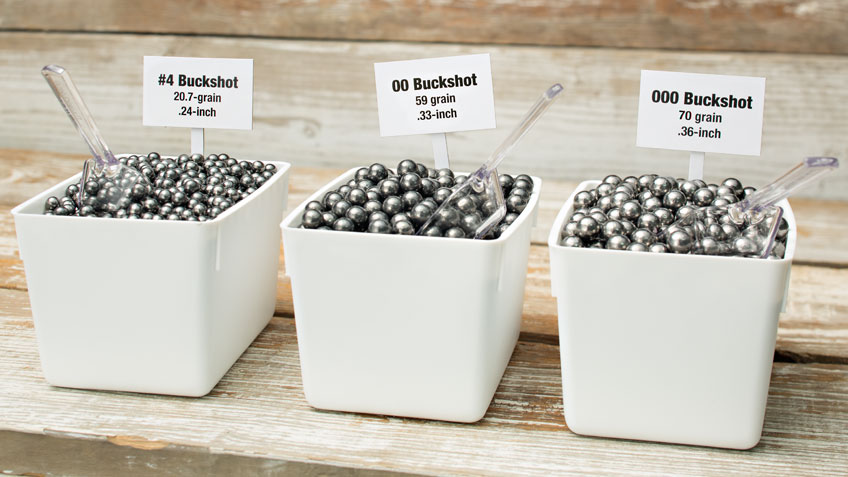
I crack up when keyboard commandoes discuss the finer points of combat flashlights and tourniquets, handgun calibers and batteries for red-dot sights, but then when it comes to loads for their customized home-defense shotgun they just say, “buckshot.” That’s like saying “surprise me” when the server asks you what kind of beer you’ll have.
“Buckshot” is a general term that historically means any pelleted shotgun load where the individual pellets are big enough to bring down medium-size game such as deer. More-modern uses of the term “buckshot,” however, usually mean 00 buck. That’s right, “double aught.” If you want No. 4 buckshot from the guy behind the counter, specify “Number 4 buck”—else you might just wind up with 00 buck.
That’s really all one needs to know about buckshot because you can’t go wrong with any version of full-power 00 buck, but if you’d like to get technical—which is what we do here at SI—here goes. There are many varieties of buckshot, and here are few points to consider:
Pellet Size
Of course, buckshot is classified by pellet size. The bigger the pellet, the more its energy, but the fewer pellets in the pattern. The number of pellets that can be stuffed into each shell is often—but not necessarily—determined by gauge and shell length. (For simplicity, let’s stick to 12-gauge for now, and the U.S. shot sizes, not the UK’s, which it calls SG.)
Pellet Material
All buckshot isn’t just round, pure-lead pellets. Some companies plate the pellets in material such as copper. This keeps them round so they’ll fly better and stay together better as a uniform pattern, but it also prevents them from expanding—or flattening on impact—as much. Buffering of the shot column protects the pellets from each other so they don’t deform as much on setback, which also produces more-uniform patterns. Various styles of protective wads do the same thing.
Load Velocity
Then there’s the shell’s velocity, which, when combined with the shell’s payload weight, dictates its energy and, accordingly, its recoil. If it weren’t for recoil, everyone would shoot 2.5-ounce loads of 000 buck at 1,700 fps. But, from an 8-pound gun that theoretical load would produce 158 ft.-lbs. of energy—nearly three times more than a .416 Rigby elephant gun—it would likely break your shoulder and detach your retinas on the first shot. Therefore, shooters should pick a reasonable round that they can handle. Still, I tend to lean toward the magnum end for home defense, because the recoil isn’t going to hurt me nearly as much as that extra energy penetration and tissue shock is going to hurt an assailant. Some people argue differently; they say even a reduced-recoil shotgun load is devastating, so why make follow-up shots that much harder. Many folks say the average 2¾-inch 00-buck loads are perfect. Me? I like 3-inch shells up around 1,300 fps or better when it’s “go-time.”
My Buckshot Load
Just like my concealed-carry-gun ammo and my hunting bullets when I’m taking an expensive elk-hunting trip, I don’t go cheap on my buckshot. I like powerful, buffered, copper-plated, waterproof loads that I can count on every time.
For pellet size, there’s no disputing that the bigger the pellet, the more it penetrates and the more energy it delivers. I prefer penetration over expansion when dealing with big, slower projectiles, so I like big pellets for my bedside gun. It’s my life and my choice. But, at some point you can start to reduce a shotgun’s strength—its pattern—if you go too big on its pellets. While there are valid arguments for No. 1 buck and 0 buck, 00 is a great balance of density and individual pellet energy. If you have to shoot through a barrier, you can. It’s so common and proven and I’m not convinced anything is better. As for pellet count, the 12-pellet 00 buck shells provide a balance between a full pattern, great downrange energy and recoil that I can handle, especially when mitigated via the use of a heavy-ish semi-automatic shotgun with a good recoil pad.
Specifically, I like a 2¾- or 3-inch, high-velocity, 00 buckshot, 12-pellet, buffered and copper-plated load such as Winchester’s Double X Hi-Velocity buckshot. At 1,450 fps, it kicks like a mule even in my heavy Remington Versa Max Tactical, but I’d sure hate to be on the other side of it. For practice, I prefer a 2¾ nine-pellet, all-lead round that’s cheap. While this is my choice, the reality is, any 00-buck load should work just fine for home defense.





































